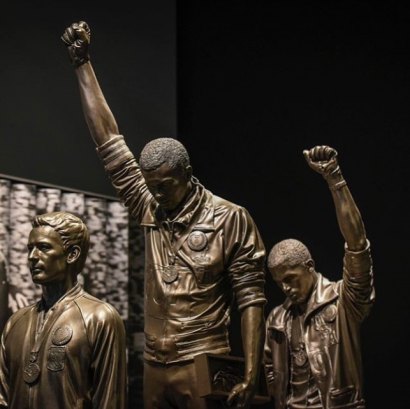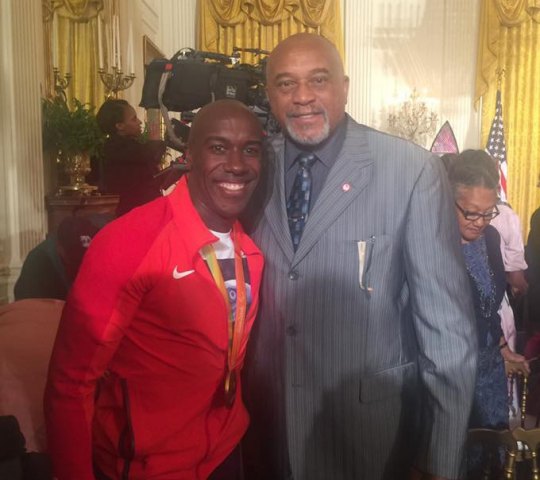Lemoore native Tommie Smith gets U.S. Olympic organization's highest honor - after 51 years
The photo of Smith, and bronze medal winner John Carlos, who was also expelled, is perhaps the sporting world’s most famous image.
Smith is unquestionably Lemoore High School’s most famous athlete, and years later, the same organization that once banned him, is now honoring him in an extraordinary way.
Nearly 51 years after his expulsion, Smith, along with fellow sprinter and bronze medal winner Carlos, is being honored by the U.S. Olympic and Paralympic Committee and will be part of the organization’s next hall of fame class, scheduled for Nov. 1 in Colorado Springs.
In addition to Smith and Carlos, this year’s inductees include basketball player Lisa Leslie, beach volleyball player Misty May-Treanor, gymnast Nastia Liukin, speedskater Apolo Anton Ohno, swimmer Dara Torres, and the 1998 U.S. Olympic women’s ice hockey team.
Smith’s and teammate John Carlos’ iconic gesture – while accepting their medals in 1968 - was meant to be a silent gesture in protest of the ongoing civil rights injustices in America.
The Olympic Committee didn’t see it that way and promptly booted them from the Olympic Games.
According to the Washington Post, both Smith and Carlos, once ostracized from the Olympic community, have seen a turnaround as time rolls on. They are regarded as “iconic activists and accomplished athletes.” In fact, in 2016 they visited President Obama’s White House, along with that year’s U.S. Summer Olympics team.
At that event, Smith met another Lemoore Olympic athlete, Jerome Avery, a Lemoore High School grad and talented sprinter who helped guide a blind athlete to gold in the 2016 Paralympics in Rio de Janeiro.
“Status quo was the order of the day back then. It was all about rules and regulations,” recalled Smith from his home in George where he was busy planning his annual Tommie Smith Youth Initiative, a banquet scheduled for Oct. 5 that celebrates youth.
“Now they (Olympic Committee) have more respect for the thought process of the individual,” a process that wasn’t necessarily allowed in 1968. “We decided to do what we believe,” he said, adding that the 1968 Olympic organizers didn’t necessarily appreciate what they did when they told them to leave.
He learned of his induction into the U.S. Olympic and Paralympic Hall of Fame from the organization’s president. “I got a call from the president of the United States Olympic Committee,” said Smith. “It’s a whole new generation. “I think right now the Olympic Committee has grown to a place where it recognizes the athlete more.”
Smith is almost giddy about the event. “I’ll be there with bells on,” he said. ”I’m excited about being there. You better believe it.”

Smith’s values were nurtured in Lemoore, a place that allowed a talented young man to succeed. What did Lemoore teach him? “To do right,” he said without equivocation. There are a lot of ways you can do right. I often come back to Lemoore because I still have a Lemoore heart. I have a Valley heart. I always look forward to coming to Lemoore. I always do.”
Smith, already a world-class athlete while still in high school, was a track and field phenom who also played a mean game of football for the Tigers. He later attended San Jose State University and in 1968, he earned a spot on the U.S. Olympic team bound for Mexico City.
Smith was so dominant in his sport that with all-time bests of 10.1 in the 100 meters, 19.83 seconds for the 200 meters, and 44.5 seconds in the 400 meters, Smith still ranks high on the world’s all-time track and field marks. In the Olympic Games, Smith easily won the 200-meter final with his record-setting 19.83 seconds.
During his career, the talented Smith set seven individual world records and was a member of several world record relay teams while at San Jose State.
Time has a way of healing for some people. Some once scorned Smith for his Mexico City stance. However, Smith has become somewhat of an iconic, well-respected figure in the sports world – and in his hometown.
Smith is a reverential figure in Lemoore’s history. He has been honored many times by his former hometown. He was an original member of the first group to be named to the Lemoore High School Foundation Hall of Fame and a monument dedicated to the Olympic gold medal winner graces Lemoore’s Tiger Stadium entrance.
Well over a decade ago, hundreds gathered in Lemoore’s Senior Citizens building to honor the famous athlete. Lemoore’s mayor at the time even presented Smith with a city proclamation.
His college alma mater, San Jose State, honored Smith and Carlos with a statue. In 2009 the two earned the Arthur Ashe Courage Award.
Smith is remembered by Lemoore’s native sons as someone well respected by his fellow students at Lemoore High School and the community, remembered longtime Lemoore educator Bob Clement who before his recent retirement from West Hills College, was the school’s athletic director. He also taught and coached baseball for decades at Lemoore High School. Clement was an LHS freshman when Smith was a senior and at the time a nationally recognized athlete. “He ended up becoming a community college athletic director,” recalled Clement. “He called me when I was the athletic director at West Hills College. He wanted to ask me some questions.”
Smith was the athletic director at Santa Monica Community College in Southern California at the time. “He just asked me some questions about the Community College Athletic Director’s Association. That was a phone call out of nowhere for me.”
Clement remembers Smith as a great athlete and a good person. “I was in the choir and Tommie was in the choir,” recalled the former Tiger baseball coach. “I have memories of going to different performances here in the community. I had a chance to get to know Tommie.
“One of the highlights for me was in 1963, Tommie’s senior year. I saw him in a relay race. Lemoore qualified for the state meet, and it was held at UC Berkeley. I went with friends to that meet. He was at the same hotel, and I had a chance to talk to him.
“Tommie was the “guy” on campus back then,” remembered Clement. “He got so much notoriety for his skills as a track and field athlete. He was very much respected and idolized at that time.
“He’s a hometown boy, and he still loves Lemoore. It’s his home. Tommie did a lot of good things for the community when he was here, particularly in high school. Those are my memories of him.”
Features
- West Hills College District announces grant award from U.S. Dept. of Agricuture for broadband services
- Local athlete, Lexus Ramirez, seeks success at Olympic boxing qualifiers in Louisiana
- NAS Lemoore Argonauts (VFA-147) to welcome a new commanding officer
- Tachis host 'Sling'em' Kids Classic Horseshoe Tournament on Saturday
- Lemoore officer and others honored at annual Public Safety Appreciation Luncheon July 13
- Annual Public Safety appreciation Luncheon is scheduled for July 13
_0.jpg)

.jpg)





